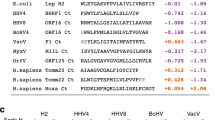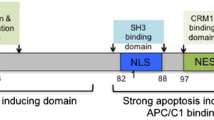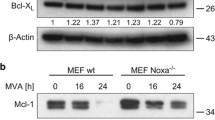Abstract
The grouper iridovirus (GIV) belongs to the family Iridoviridae, whose genome contains an antiapoptotic B-cell lymphoma (Bcl)-2-like gene. This study was carried-out to understand whether GIV blocks apoptosis in its host. UV-irradiated grouper kidney (GK) cells underwent apoptosis. However, a DNA fragmentation assay of UV-exposed GK cells after GIV infection revealed an inhibition of apoptosis. The UV- or heat-inactivated GIV failed to inhibit apoptosis, implying that a gene or protein of the viral particle might contribute to an apoptosis inhibitory function. The DNA ladder assay for GIV-infected GK cells after UV irradiation confirmed that apoptosis inhibition was an early process which occurred as early as 5 min post-infection. A GIV-Bcl sequence comparison showed distant sequence similarities to that of human and four viruses; however, all possessed the putative Bcl-2 homology (BH) domains of BH1, BH2, BH3, and BH4, as well as a transmembrane domain. Northern blot hybridization showed that GIV-Bcl transcription began at 2 h post-infection, and the mRNA level significantly increased in the presence of cycloheximide or aphidicolin, indicating that this GIV-Bcl is an immediate-early gene. This was consistent with the Western blot results, which also revealed that the virion carries the Bcl protein. We observed the localization of GIV-Bcl on the mitochondrial membrane and other defined intracellular areas. By immunostaining, it was proven that GIV-Bcl-expressing cells effectively inhibited apoptosis. Taken together, these results demonstrate that GIV inhibits the promotion of apoptosis by GK cells, which is mediated by the immediate early expressed viral Bcl gene.








Similar content being viewed by others
References
Antonsson B, Martinou JC (2000) The Bcl-2 protein family. Exp Cell Res 256:50–57
Adams JM, Cory S (1998) The Bcl-2 protein family: arbiters of cell survival. Science (New York, NY) 281:1322–1326
Tsujimoto Y (1998) Role of Bcl-2 family proteins in apoptosis: apoptosomes or mitochondria? Genes Cells 3:697–707
Gibson L, Holmgreen SP, Huang DC et al (1996) Bcl-w, a novel member of the bcl-2 family, promotes cell survival. Oncogene 13:665–675
Thornberry NA, Lazebnik Y (1998) Caspases: enemies within. Science (New York, NY) 281:1312–1316
Knezevic D, Zhang W, Rochette PJ, Brash DE (2007) Bcl-2 is the target of a UV-inducible apoptosis switch and a node for UV signaling. Proc Natl Acad Sci U S A 104:11286–11291
Shimizu S, Konishi A, Kodama T, Tsujimoto Y (2000) BH4 domain of antiapoptotic Bcl-2 family members closes voltage-dependent anion channel and inhibits apoptotic mitochondrial changes and cell death. Proc Natl Acad Sci U S A 97:3100–3105
Zou H, Henzel WJ, Liu X, Lutschg A, Wang X (1997) Apaf-1, a human protein homologous to C. elegans CED-4, participates in cytochrome c-dependent activation of caspase-3. Cell 90:405–413
Li P, Nijhawan D, Budihardjo I et al (1997) Cytochrome c and dATP-dependent formation of Apaf-1/caspase-9 complex initiates an apoptotic protease cascade. Cell 91:479–489
Yang J, Liu X, Bhalla K et al (1997) Prevention of apoptosis by Bcl-2: release of cytochrome c from mitochondria blocked. Science (New York, NY) 275:1129–1132
Kluck RM, Bossy-Wetzel E, Green DR, Newmeyer DD (1997) The release of cytochrome c from mitochondria: a primary site for Bcl-2 regulation of apoptosis. Science (New York, NY) 275:1132–1136
Everett H, McFadden G (1999) Apoptosis: an innate immune response to virus infection. Trends Microbiol 7:160–165
Tortorella D, Gewurz BE, Furman MH, Schust DJ, Ploegh HL (2000) Viral subversion of the immune system. Annu Rev Immunol 18:861–926
Henry H, Thomas A, Shen Y, White E (2002) Regulation of the mitochondrial checkpoint in p53-mediated apoptosis confers resistance to cell death. Oncogene 21:748–760
Marshall WL, Yim C, Gustafson E et al (1999) Epstein-Barr virus encodes a novel homolog of the bcl-2 oncogene that inhibits apoptosis and associates with Bax and Bak. J Virol 73:5181–5185
Postigo A, Cross JR, Downward J, Way M (2006) Interaction of F1L with the BH3 domain of Bak is responsible for inhibiting vaccinia-induced apoptosis. Cell Death Differ 13:1651–1662
Williams T, Chinchar VG, Darai G, Hyatt A, Kalmakoff J, Seligy V (2000) Iridoviridae. In: van Regenmortel MHV [DHLBEBC?], Estes MK, Lemon SM, Maniloff J, Mayo MA, McGeoch DJ, Pringle CR, Wickner RB (eds) Seventh report of the International Committee on the taxonomy of viruses. International Committee on Taxonomy of Viruses (ICTV), Orlando, FL, pp 167–182
Lai YS, Murali S, Ju HY et al (2000) Two iridovirus-susceptible cell lines established front kidney and liver of grouper, Epinephelus awoara (Temminck & Schlegel), and partial characterization of grouper iridovirus. J Fish Dis 3:379–388
Lai YS, John JAC, Lin CH et al (2003) Establishment of cell lines from a tropical grouper, Epinephelus awoara (Temminck & Schlegel), and their susceptibility to grouper irido- and nodaviruses. J Fish Dis 6:31–42
Imajoh M, Sugiura H, Oshima S (2004) Morphological changes contribute to apoptotic cell death and are affected by caspase-3 and caspase-6 inhibitors during red sea bream iridovirus permissive replication. Virology 22:220–230
Chinchar VG, Bryan L, Wang J, Long S, Chinchar GD (2003) Induction of apoptosis in frog virus 3-infected cells. Virology 306:303–312
Essbauer S, Ahne W (2002) The epizootic haematopoietic necrosis virus (Iridoviridae) induces apoptosis in vitro. J Vet Med 49:25–30
Hu GB, Cong RS, Fan TJ, Mei XG (2004) Induction of apoptosis in a flounder gill cell line by lymphocystis disease virus infection. J Fish Dis 27:657–662
Paul ER, Chitnis NS, Henderson CW, Kaul RJ, D’Costa SM, Bilimoria SL (2007) Induction of apoptosis by iridovirus virion protein extract. Arch Virol 152:1353–1364
Huang YH, Huang XH, Gui JF, Zhang QY (2007) Mitochondrion-mediated apoptosis induced by Rana grylio virus infection in fish cells. Apoptosis 12:1569–1577
Tsai CT, Ting JW, Wu MH, Wu MF, Guo IC, Chang CY (2005) Complete genome sequence of the grouper iridovirus and comparison of genomic organization with those of other iridoviruses. J Virol 79:2010–2023
Murali S, Wu MF, Guo IC, Chen SC, Yang HW, Chang CY (2002) Molecular characterization and pathogenicity of a grouper iridovirus (GIV) isolated from yellow grouper, Epinephelus awoara (Temminck & Schlegel). J Fish Dis 25:91–100
Chen WY, John JAC, Lin CH, Chang CY (2007) Expression pattern of metallothionein, MTF-1 nuclear translocation, and its DNA-binding activity in zebrafish (Danio rerio) induced by zinc and cadmium. Environ Toxicol Chem 26:110–117
Yao YL, Yang WM (2003) The metastasis-associated proteins 1 and 2 form distinct protein complexes with histone deacetylase activity. J Biol Chem 278:42560–42568
Altschul SF, Madden TL, Schaffer AA et al (1997) Gapped BLAST and PSI-BLAST: a new generation of protein database search programs. Nucleic Acids Res 25:3389–3402
Thompson JD, Gibson TJ, Plewniak F, Jeanmougin F, Higgins DG (1997) The CLUSTAL_X windows interface: flexible strategies for multiple sequence alignment aided by quality analysis tools. Nucleic Acids Res 25:4876–4882
Muchmore SW, Sattler M, Liang H et al (1996) X-ray and NMR structure of human Bcl-xL, an inhibitor of programmed cell death. Nature 381:335–341
Hong JR, Gong HY, Wu JL (2002) IPNV VP5, a novel anti-apoptosis gene of the Bcl-2 family, regulates Mcl-1 and viral protein expression. Virology 295:217–229
Ross L, Guarino LA (1997) Cycloheximide inhibition of delayed early gene expression in baculovirus-infected cells. Virology 232:105–113
Hockenbery DM, Oltvai ZN, Yin XM, Milliman CL, Korsmeyer SJ (1993) Bcl-2 functions in an antioxidant pathway to prevent apoptosis. Cell 75:241–251
Chelbi-Alix MK, Quignon F, Pelicano L, Koken MHM, De The H (1998) Resistance to virus infection conferred by the interferon-induced promyelocytic leukemia protein. J Virol 72:1043–1051
Wold WSM, Doronin K, Toth K, Kuppuswamy M, Lichtenstein DL, Tollefson AE (1999) Immune responses to adenoviruses: viral evasion mechanisms and their implications for the clinic. Curr Opin Immunol 11:380–386
Aubert M, Pomeranz LE, Blaho JA (2007) Herpes simplex virus blocks apoptosis by precluding mitochondrial cytochrome c release independent of caspase activation in infected human epithelial cells. Apoptosis 12:19–35
Isoherranen K, Sauroja I, Jansen C, Punnonen K (1999) UV irradiation induces downregulation of bcl-2 expression in vitro and in vivo. Arch Dermatol Res 291:212–216
Srivastava RK, Mi QS, Hardwick JM, Longo DL (1999) Deletion of the loop region of Bcl-2 completely blocks paclitaxel-induced apoptosis. Proc Natl Acad Sci U S A 96:3775–3780
Kelekar A, Thompson CB (1998) Bcl-2-family proteins: the role of the BH3 domain in apoptosis. Trends Cell Biol 8:324–330
Yin XM, Oltvai ZN, Korsmeyer SJ (1994) BH1 and BH2 domains of Bcl-2 are required for inhibition of apoptosis and heterodimerization with Bax. Nature 369:321–323
Carter DA (1993) Up-regulation of beta 1-adrenoceptor messenger ribonucleic acid in the rat pineal gland: nocturnally, through a beta-adrenoceptor-linked mechanism, and in vitro, through a novel posttranscriptional mechanism activated by specific protein synthesis inhibitors. Endocrinology 133:2263–2268
Oguchi S, Weisz A, Esumi H (1994) Enhancement of inducible-type NO synthase gene transcription by protein synthesis inhibitors. Activation of an intracellular signal transduction pathway by low concentrations of cycloheximide. FEBS Lett 338:326–330
Nguyen M, Millar DG, Yong VW, Korsmeyer SJ, Shore GC (1993) Targeting of Bcl-2 to the mitochondrial outer membrane by a COOH-terminal signal anchor sequence. J Biol Chem 268:25265–25268
Senftleben U, Karin M (2002) The IKK/NF-kappaB pathway. Crit Care Med 30:S18–S26
Acknowledgements
This study was supported by grant no. NSC95-2311-B-001-069-MY3 from the National Science Council, Taiwan.
Author information
Authors and Affiliations
Corresponding author
Rights and permissions
About this article
Cite this article
Lin, PW., Huang, YJ., John, J.A.C. et al. Iridovirus Bcl-2 protein inhibits apoptosis in the early stage of viral infection. Apoptosis 13, 165–176 (2008). https://doi.org/10.1007/s10495-007-0152-y
Published:
Issue Date:
DOI: https://doi.org/10.1007/s10495-007-0152-y




